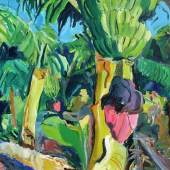Donazione Carlo e Giovanni Moretti 1958-2013 | Glass Museum
-
Ausstellung06.12.2024 - 30.06.2025
An exhibition to celebrate the experience and history of an enlightened creativity, to remember two gentlemen of glass, Carlo and Giovanni Moretti, and their entrepreneurial adventure that has left an indelible and immediately recognisable mark to the present day.
Curated by Chiara Squarcina, Mauro Stocco and Marta Moretti, the exhibition will make it possible for the first time for the public to admire the larger part of the important and notable donation of over 400 works by the Carlo Moretti company, which was received by the Museo del Vetro in 2020 and which provides a rich, precise and exhaustive overview of the historical events of the company created by Carlo and Giovanni Moretti in 1958 and the evolution of its successful production, up to 2013, when the company changed hands.
The adventure began, as per tradition, with the creation of transparent glassware and coloured glasses, characterised by the constant striving for clean and essential lines, combined with technical innovation and the fine-tuning of the work tools. Their desire to leave a mark that would be able to say something to today’s world, going beyond the borders of the island and Murano and seeking an international outlook, immediately became clear. Theirs were two different but perfectly complementary personalities: Carlo with his refined and cultured taste, with his proceeding by subtraction to the point of achieving a formal essentiality that soon became his signature, the stylistic code by which he is still known throughout the world; Giovanni, on the other hand, sensitive to market trends and an intuitive anticipator of tastes and needs, capable of creating the narrative that best accompanied their products, infecting interlocutors and customers with his enthusiasm.
At the beginning of the 1960s, Carlo Moretti put into production the first series of two-colour glassware (milky inside and coloured outside) and later the successful Satinati series, made for Bloomingdale's department store in New York. Thus began the process of establishing the company on foreign markets. Carlo Moretti's stylistic signature is the adoption of simple, basic shapes and essential lines for goblets and cups, mostly composed of geometries based on cylinders and spheres.
The 1970s represented the period of greatest innovation for Carlo Moretti, which also manifested itself in technical research aimed at improving the quality of raw materials and in the desire to affirm a precise expressive language. These years saw the revival of traditional Murano crystal in the company, which became a true trademark for Carlo Moretti, identified with the elegance and lightness of its products. Extraordinary designs were born, such as the Octagonal glass of 1974 and the Oval of 1976.
A turning point in the formal repertoire came during the 1980s with the glassware that best identified the company's production and its stylistic signature: sober crystal objects of great refinement, often finished by grinding alone, such as the Millemolature and Bande molate series of 1984.
Also on display will be the famous series of Calici da collezione, launched for Christmas 1990, which were the brainchild of Giovanni Moretti. Each year renewed in colour, shape and decoration, the Chalices were an immediate commercial success.
In terms of more strictly artistic creations, the Monolite project also dates back to the 1990s. These were heavy glass sculptures inspired by the nocturnal cityscape of Manhattan. They were created using a special technique of fusion in a furnace. A large part of the production in the 2000s was characterised by the use of paste glass, with each object signed by hand using the point of a diamond, to make it unmistakable and unique.
Now, as then, the soul of Venice emerges in their creations, that extraordinary capacity of Venice to be both liquid and solid, transparent and opaque, to be a culture and a society that preserves itself and, at the same time, allows itself to be fertilised by fresh input from beyond its shores. Fluid like the alternating motion of the tides, like the breath used to blow glass.
-
02.10.2024The eighth edition of The Venice Glass Week, the international festival dedicated to the art of...
-
24.11.2023 - 29.02.2024The Venice Glass Week e Comune di Venezia presentano Murano Illumina il Mondo Il vetro di Murano...
-
04.09.2021 - 12.09.2021The Venice Glass Week presents its ffth edition - #VivaVetro! - taking place around Venice,...
-
Das Glass Museum in Murano ist ein unvergleichliches Zentrum für die Bewahrung und Feier der...
-
Deutsches und böhmisches Antikes Pottaschenglas Im 13. und 14. Jh. entstanden Glashü...
-
06.12.2024 - 30.06.2025An exhibition to celebrate the experience and history of an enlightened creativity, to remember...
-
06.12.2024 - 30.06.2025
From Monday 26 April everyday 10.00 – 18.00 (last admission 17.00)





















